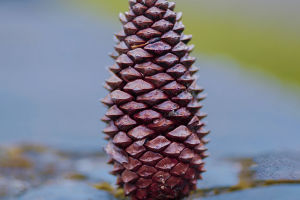Dandelion seeds are among the most capable of flying in nature.
Recently, research from the University of Edinburgh in the UK found that the extraordinary flying ability of dandelion seeds is due to a flight method that has never been discovered in nature before.
To achieve this long distance, the dandelion's pappus creates strange vortices in the surrounding air. These annular bubbles can form above the dandelion seeds, increasing air resistance and slowing the seeds' descent like a parachute. The study was published Oct. 17 in the journal Nature.
Dandelion flowers are a collection of individual seeds attached to an umbrella-shaped tuft of hair, somewhat similar in shape to a brush. While most dandelion seeds ultimately land less than 2 meters from the flower, these seeds can easily fly more than 1 kilometer in warm, dry air.
The flight of dandelions is fascinating, but the mechanism behind it has baffled scientists. "It's a strange structure," said co-author Naomi Nakayama, a biophysicist at the University of Edinburgh. "No one knows how dandelion seeds fly."
An umbrella tuft will have 100-110 filaments, which have a larger surface area compared to the area of the dandelion seeds they carry. Scientists believe that dandelion seeds can fly through the resistance of a single filament. By combining fluid mechanics and plant biology, the Edinburgh team found that drag effects alone cannot explain why dandelion seeds are so good at staying airborne.
"We had reason to believe that the lift provided by a single filament was not sufficient to keep the dandelion aloft for long periods. Therefore, we decided to investigate whether there was an interaction between the filaments and whether this interaction was strong enough to affect the flight," explains Ignazio Maria Viola, who led the study on fluid dynamics.
To analyze the seeds, the team built a vertical wind tunnel that allowed the seeds to continuously hover at one altitude. The researchers used a combination of long-exposure photography and high-speed imaging to analyze the surrounding airflow. They also used X-ray imaging and microscopy to examine the morphology of the dandelions themselves.
Wind tunnel experiments showed that the air directly above the dandelion filaments formed a 'separated vortex ring.' When fluid flows past an object or obstacle, it forms a vortex ring that breaks away from the surface of the object. 'The existence of vortices has been considered from a theoretical perspective in the past, but some thought it was unlikely to occur in nature,' Viola explains.
It turns out that vortices can be stabilized by airflow through the filaments. As air flows around each filament, it also interacts with the flow of its neighboring filaments, creating what's known as a "wall effect." (The effect caused by the interaction of a fluid with a surface as it flows over it.) Due to this interaction, the flow through the filaments is significantly reduced, which makes the dandelion seeds float more effectively.
Once the detached vortex stabilizes, it increases the seed's ability to fly because it gives the seed an upward force. What's more, the dandelion's parachute-shaped structure is four times more effective at keeping seeds of similar mass aloft compared to the parachute-shaped structure.
By drawing on the wisdom of nature, we may be able to develop more efficient and environmentally friendly flight technology, bringing greater convenience and possibility to environmental monitoring and scientific research. The results of this research are exciting and have triggered curiosity and exploration of more unknown mysteries in nature.


